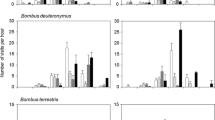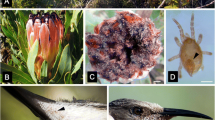Abstract
Nectarivorous flower mites (Mesostigmata: Melicharidae) live mostly on hummingbird-pollinated plants in the New World. We observed Proctolaelaps sp. living on Neoregelia johannis (Bromeliaceae) in a coastal rain forest site in south-eastern Brazil. Flower anthesis of this bromeliad lasted a single day. We recorded mites moving into, feeding from, presumably mating and reproducing, and exiting bromeliad flowers within just a single day. We observed three ant species predating flower mites on bromeliads. The main visitor was the bumblebee Bombus morio, which always landed on the inflorescence to access nectar inside the bromeliad flowers. We found Proctolaelaps sp. mites on 47% of 38 bumblebees inspected, with each Bombus hosting 2 mites on average; only adults and mostly female mites (93%) usually found on the bumblebees’ gula region of the head. This is the first study to document nectarivorous flower mites living on a melittophilous host plant using bumblebees for phoretic dispersal.

Similar content being viewed by others
References
Araujo A.C., Fischer E.A. and Sazima M. 2004. As bromélias na região do Rio Verde. In: Estação Ecológica Juréia-Itatins: Ambiente Físico, Flora e Fauna (Marques O. and Duleba W., Eds), Holos Editora, Ribeirão Preto. pp 162-171
Baker E.W. and Yunker C.E. 1964. New blattisociid mites (Acarina: Mesostigmata) recovered from neotropical flowers and hummingbirds’ nares. Ann. Entomol. Soc. Am. 57: 103-126
Boggs C.L. and Gilbert L.E. 1987. Spatial and temporal distribution of Lantana mites phoretic on butterflies. Biotropica 19: 301-305
Canela M.B.F. and Sazima M. 2005. The pollination of Bromelia antiacantha (Bromeliaceae) in Southeastern Brazil: ornithophilous versus melithophilous features. Plant Biol. 7: 411-416
Colwell R.K. 1973. Competition and coexistence in a simple tropical community. Am. Nat. 107: 737-760
Colwell R.K. 1979. The geographical ecology of hummingbird flower mites in relation to their host plants and carriers. In: Recent Advances in Acarology (Rodríguez J.G., Ed), Academic Press, New York. pp 461-468
Colwell R.K. 1985. Stowaways on the hummingbirds express. Nat. Hist. 94: 56-63
Colwell R.K. and Naeem S. 1994. Life-history patterns of hummingbird flower mites in relation to host phenology and morphology. In: Mites: Ecological and Evolutionary Analyses of Life-History Patterns (Houck M.A., Ed), Chapman & Hall, New York. pp 23-44
Dobkin D.S. 1984. Flowering patterns of long-lived Heliconia inflorescences: implications for visiting and resident nectarivores. Oecologia 64: 245-254
Dusbabek F., Literak I., Capek M. and Havlicek M. 2007. Ascid mites (Acari: Mesostigmata: Ascidae) from Costa Rican hummingbirds (Aves: Trochilidae), with description of three new species and a key to the Proctolaelaps belemensis species group. Zootaxa 1484: 51-67
Eickwort G.C. 1994. Evolution and life-history patterns of mites associated with bees. In: Mites: Ecological and Evolutionary Analyses of Life-History Patterns (Houck M.A., Ed), Chapman & Hall, New York. pp 218-251
Garcia-Franco J.G., Burgoa D.M. and Pérez T.M. 2001. Hummingbird flower mites and Tillandsia spp. (Bromeliaceae): polyphagy in a cloud forest of Veracruz, Mexico. Biotropica 33: 538-542
Krantz G.W. and Walter D.E. 2009. A Manual of Acarology. Third edition. Texas Tech University Press, Texas. 807 pp
Lara C. and Ornelas J.F. 2002. Flower mites and nectar production on six hummingbird-pollinated plants with contrasting flower longevities. Can. J. Bot. 80: 1216-1229
Naskrecki P. and Colwell R.K. 1998. Systematics and host plant affiliations of hummingbird flower mites of the genera Tropicoseius Baker and Yunker and Rhinoseius Baker and Yunker (Acari: Mesostigmata: Ascidae). Thomas Say Publications in Entomology: Monographs. Entomol. Soc. Am., Lanham, Maryland, 185 pp
Nawar M.S. 1992. Life tables of Proctolaelaps deleoni Nawar, Childers and Abou-Setta (Gamasida: Ascidae) at different temperatures. Exper. Appl. Acarol. 13: 281-285
O’Connor B.M., Colwell R.K. and Naeem S. 1991. Flower mites of Trinidad II. The genus Proctolaelaps (Acari: Ascidae). Gr. Bas. Nat. 51: 348-376
Schwarz H.H. and Huck K. 1997. Phoretic mites use flowers to transfer between foraging bumblebees. Insect. Soc. 44: 303-310
Seeman O.D. and Walter D.E. 1995. Life history of Afrocypholaelaps africana (Evans) (Acari: Ameroseidae), a mite inhabiting mangrove flowers and phoretic on honeybees. J. Aust. Entomol. Soc. 34: 45-50
Siqueira-Filho J.A. and Machado I.S.C. 2001. Biologia reprodutiva de Canistrum aurantiacum E. Morren (Bromeliaceae) em remanescente da Floresta Atlântica, Nordeste do Brasil. Act. Bot. Bras. 15: 427-444
Royce L.A. and Krantz G.W. 1989. Observations on pollen processing by Pneumolaelaps longanalis (Acari: Laelapidae), a mite associate of bumblebees. Experi. Appl. Acarol. 7: 161-165
Ramanan V.R. and Ghai S. 1984. Observations on the mite Neocypholaelaps indica Evans and its relationship with the honey bee Apis cerana indica Fabricius and the flowering of Eucalyptus trees. Entomon 9: 291-299
Treat A.E. and Niederman L. 1967. Three species of Proctolaelaps (Acarina, Mesostigmata) from noctuid moths. Amer. Mus. Nov. 2312: 1-12
Tschapka M. and Cunningham S.A. 2004. Flower mites of Calyptrogyne ghiesbreghtiana (Arecaceae): evidence for dispersal using pollinating bats. Biotropica 36: 377-381
Acknowledgments
We thank G. Martinelli, C. Matos and F.S. Castro, for identification of bromeliad, bees and ants, respectively. We also thank one anonymous reviewer and R.K. Colwell for comments and suggestions on the manuscript. This work was conducted during Ecology Field Course totally supported by Programa de Pós-Graduação em Ecologia at Universidade Estadual de Campinas, coordinated by W.W. Benson and A.V.L. Freitas. T.J. Guerra was supported by doctoral scholarship from CAPES. G.Q. Romero was supported by research grants from Fundação de Amparo à Pesquisa do Estado de São Paulo (FAPESP, grants 04/13658-5 and 05/51421-0).
Author information
Authors and Affiliations
Corresponding author
Rights and permissions
About this article
Cite this article
Guerra, T.J., Romero, G.Q., Costa, J.C. et al. Phoretic dispersal on bumblebees by bromeliad flower mites (Mesostigmata, Melicharidae). Insect. Soc. 59, 11–16 (2012). https://doi.org/10.1007/s00040-010-0091-4
Received:
Revised:
Accepted:
Published:
Issue Date:
DOI: https://doi.org/10.1007/s00040-010-0091-4




